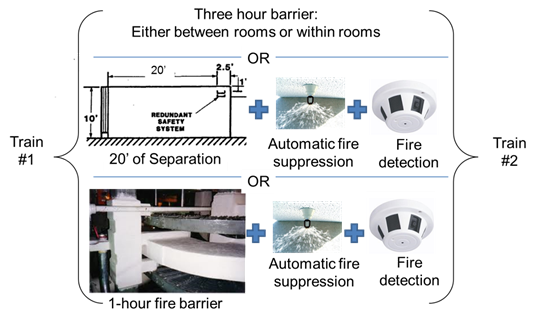Deterministic Fire Protection
The NRC uses regulation to ensure U.S. nuclear power plants are safe. Since the deterministic fire protection requirements were established, no fires have challenged safe shutdown. Every plant must have a fire protection plan that satisfies 10 CFR Part 50, Appendix A, Criterion 3 and 10 CFR 50.48(a). The fire protection plan must outline the overall fire protection program, installed fire protection systems, and the means to ensure that the reactor can be safely shutdown in the event of a fire.
Plants that were licensed before January 1, 1979 were also subject to the prescriptive requirements of 10 CFR 50.48(b) and Appendix R. Plants that were licensed after January 1, 1979 typically followed the same prescriptive requirements to demonstrate conformance with the fire protection regulations. These requirements were based on an assumed serious fire, where generic criteria were established for all plants. In cases where these requirements were not practical, or there was a more favorable approach to achieving an equivalent level of safety, applicants and licensees sought alternatives, typically through specific exemptions and amendments.
For example, one of the prescriptive requirements related to the fire protection requirements for safe shutdown capability. This regulation requires that one train of systems necessary to achieve and maintain hot shutdown is free of fire damage. The regulation prescribes that the trains will:
- Have a three hour barrier between them
- Have 20' of separation, automatic fire suppression, and fire detection, or
- Have a one hour barrier between them, automatic fire suppression, and fire detection

In some cases, the requirement to achieve 20' of separation was impractical, but the plant could still meet the performance goal: retain one train of systems free of fire damage. In these cases, the licensee could apply for and in many cases be granted an exemption by the NRC.
The NRCs regulations allow for exemptions from specific requirements of the regulations when certain enumerated special circumstances are present (10 CFR 50.12). The Commission will grant such exemptions only if they do not present an undue risk to the public health and safety and meet other requirements. A plant operating in accordance with an exemption and other regulatory requirements is considered to be in compliance with the regulations.
For further information on the NRC's deterministic fire protection requirements, refer to Regulatory Guide 1.189.
Page Last Reviewed/Updated Tuesday, March 10, 2020
Page Last Reviewed/Updated Tuesday, March 10, 2020

